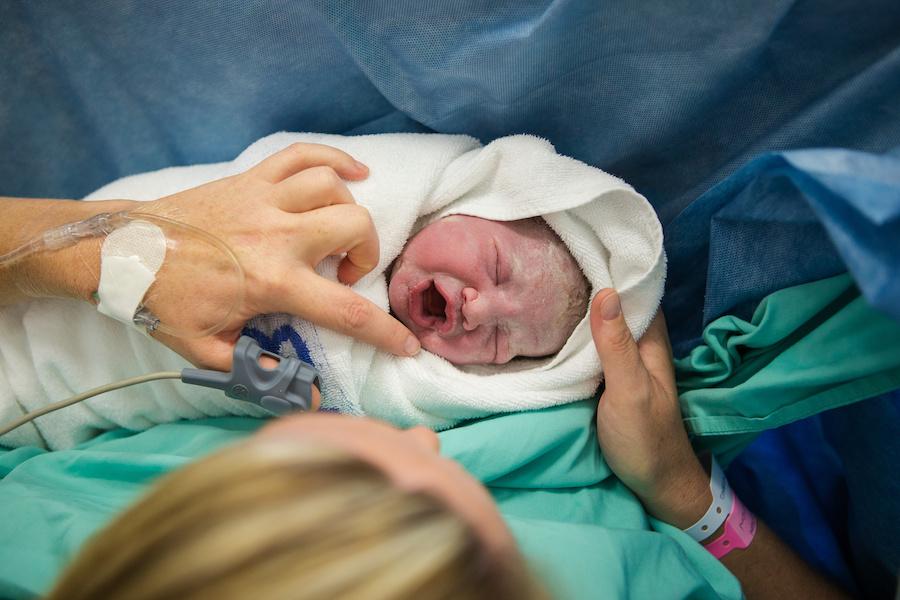Nowadays lots of children are born by cesarean section. It’s the most frequent abdominal surgical procedure in the western world, and the most common reasons for a planned cesarean are:
- The baby is in the breech position, with her/his bottom or feet first instead of her/his head
- The baby is too big in relation to the mother’s pelvis
- The mother is afraid of childbirth
- The mother or baby has a health problem
- The mother has had one or more C-sections previously.
Ask questions
Your health care provider will explain the procedure and might suggest that you speak with your anesthesiologist about any medical conditions. Ask anything you like—there are no stupid or irrelevant questions. You and your partner need to understand what will happen during the cesarean, find ways of feeling comfortable with the procedure and have a chance to feel a part of what happens. It’s a different kind of preparation from the kind you do before a vaginal birth, which is more about contractions, pain relief, breathing and relaxation.
In some hospitals it’s possible for the mother and baby to be cared for together after a C-section. What is the procedure at your hospital? Make a note of your preferences in a birth plan. Would you like to have your own music playing in the background? Do you want your partner to cut the cord after your baby is born?
During the caesarean
It’s completely normal to feel afraid and nervous before and during a C-section. Speak with your health care provider if you are feeling very afraid or nervous. Generally, your partner will be allowed to stay by your side throughout the entire operation during a planned c-section. A screen will be put up so that you can’t see the actual operation, but you will be able to hear everything that’s happening in the room. Breathing together, gently and calmly, can help you to focus and relax. Softly and tenderly stroking the mother’s cheeks and forehead also has a soothing effect. Because the operating room is full of people you don’t know, creating a little privacy for the two of you can be a challenge. One suggestion is for the partner to sit very close to the mother, hold her hand and talk to her during the operation.
The baby is born
Parents are often surprised at how quickly their baby is born by C-section. Suddenly the room is filled with the sound of a baby crying. It can be very emotional for both parents. There might be an opportunity for the mother to see her baby in the operating room and hold him or her for a moment, preferably skin-to-skin. This is especially important if mother and child are not cared for together immediately after the caesarean but will be separated for a while. At many hospitals your baby can stay with you while the surgeon sews up the incision.
Skin-to-skin care
The partner may be the one who takes care of the baby while the mother is in the recovery room immediately after a c-section Most newborns can wait a while before feeding; it’s most important that they are held close and helped to keep warm. The most effective way to do this is skin-to-skin contact, so partners are advised to wear a top with a front that can be opened easily.
Staying in hospital
A cesarean is a major operation which can take a little longer to recover from than a vaginal birth. For the wound to heal well your partner will need to take more responsibility for the baby and other practicalities while you are in hospital.
Get up and walk around early
To avoid complications after the operation it’s good to get up and start walking around as soon as possible. You’ll be able to get up sooner if you receive effective pain relief. After your cesarean you will be asked to rate your level of pain or discomfort regularly—you will be given stronger pain relief if you need it. The surgical wound may feel tight or pull a little, but it should not hurt! You are usually able to start breastfeeding straight after a C-section.
Coming home
Once back at home you’ll need to take it easy and rest as much as you can. See if you feel like having friends of relatives over to visit and don’t hesitate to turn your phone off before you try to sleep. The actual wound healing process takes a few weeks, and during that time it’s advisable not to lift anything heavier than your baby.
It’s best if you don’t do any housework during your first few weeks at home and that your partner does your share. Recovering from an operation and having a newborn baby to take care of will take up all your time and energy. Individual variations are great, but it can take up to six months to recover from a cesarean section, although many mothers feel that life is back to normal after a few weeks.
Sources:
- Myles, M.F., Marshall, J.E. & Raynor, M.D. (red.) (2014). Myles textbook for midwives. (16th edition). Edinburgh: Elsevier.
- Kaplan, A. (red.) (2009). Lärobok för barnmorskor. (3., omarb. uppl.) Lund: Studentlitteratur.
